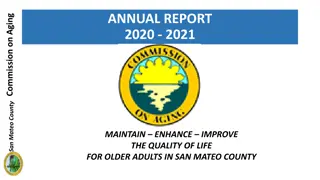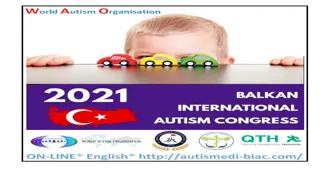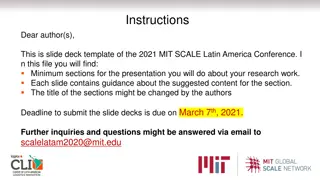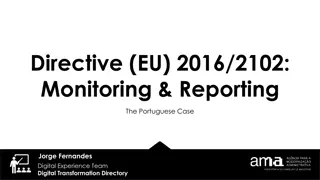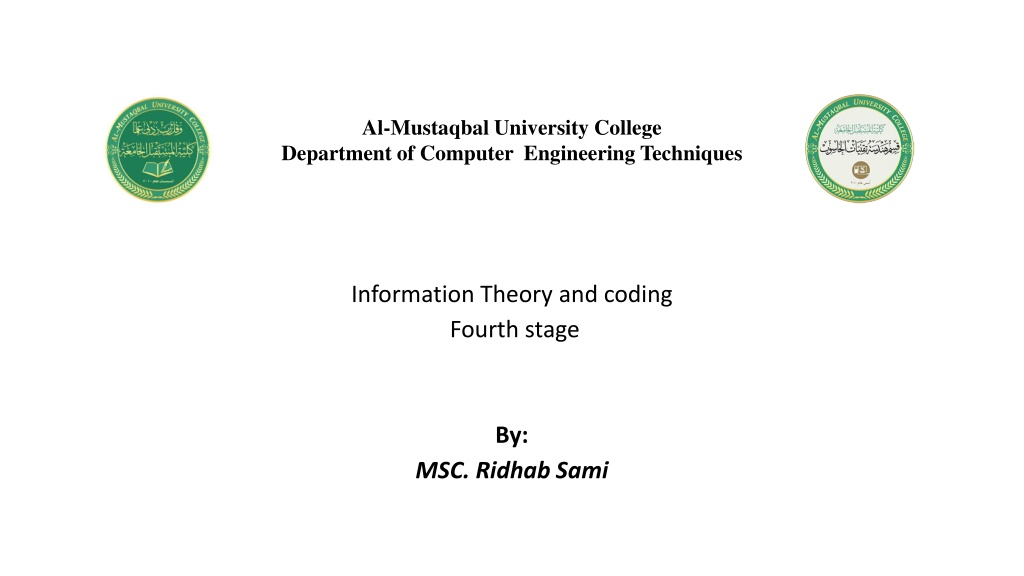
Understanding Self-Information in Information Theory and Coding
Explore the concept of self-information in information theory, measuring the information content associated with random variables. Learn about units of information like bits, nats, and hartleys, and how self-information is calculated based on probabilities. Dive into examples to grasp the practical application of self-information in communication systems.
Download Presentation

Please find below an Image/Link to download the presentation.
The content on the website is provided AS IS for your information and personal use only. It may not be sold, licensed, or shared on other websites without obtaining consent from the author. Download presentation by click this link. If you encounter any issues during the download, it is possible that the publisher has removed the file from their server.
E N D
Presentation Transcript
Al-Mustaqbal University College Department of Computer Engineering Techniques Information Theory and coding Fourth stage By: MSC. Ridhab Sami
Lecture 4 Self- information
Model of information transmission system: Transmitting a message from a transmitter to a receiver can be sketched as in Figure 1: Figure 1: Shannon paradigm
Self- information: In information theory, self-information is a measure of the information content associated with the outcome of a random variable. It is expressed in a unit of information, for example bits, nats, or hartleys, depending on the base of the logarithm used in its calculation. 1 ? ?? = ???? ?(??) ? ??= ?????(??) Where ?(??) is self -information of (??) and if: If a =2 , then ?(??) has the unit of bits i. ii. If a = e = 2.71828, then ?(??) has the unit of nats iii. If a = 10, then ?(??) has the unit of hartly A bit is the basic unit of information in computing and digital communications. A bit can have only A nat is the natural unit of information, sometimes also nit or nepit, is a unit of information or The hartley (symbol Hart) is a unit of information defined by International Standard IEC 80000-13 one of two values, and may therefore be physically implemented with a two-state device. These values entropy, based on natural logarithms and powers of e, rather than the powers of 2 and base 2 logarithms of the International Electrotechnical Commission. One hartley is the information content of an event if the are most commonly represented as 0 and 1. which define the bit. This unit is also known by its unit symbol, the nat. probability of that event occurring is 1/10. It is therefore equal to the information contained in one decimal digit (or dit).
The amount of self-information contained in a probabilistic event depends only on the probability of that event: the smaller its probability, the larger the self-information associated with receiving the information that the event indeed occurred as shown in Figure 2. i. Information is zero if ?(??) = 1 (certain event) ii. Information increase as ?(??) decrease to zero iii. Information is a +ve quantity Note: log?? =?? ? ?? ? Figure 2: Relation between probability and self-information
Example 1: A fair die is thrown, find the amount of information gained if you are told that 4 will appear. Solution: ?(1) = ?(2) = . = ?(6) = 1 6 Then: ? ??= ?????(??) 1 6 1 6 1 6 6 1 ? 4 = ???2 ? 4 = ???? ? 4 = ???10 1 1 6 ln( ln( ln 2= 2.5849 ???? ln? ln( 6 ln 10= 0.778 ???? = = = = 1.791 ????
Example 2: A biased coin has P(Head)=0.3. Find the amount of information gained if you are told that a tail will appear. Solution: ?(????) = 1 ?(????) = 1 0.3 = 0.7 ? ??= ?????(??) ? ???? = ???20.7 ) ln( 0.7 ln 2 = = 0.5145 ????
HW: A communication system source emits the following information with their corresponding probabilities as follows: A=1/2, B=1/4, C=1/8. Calculate the information conveyed by each source outputs. Draw the relation between probability and self-information.





